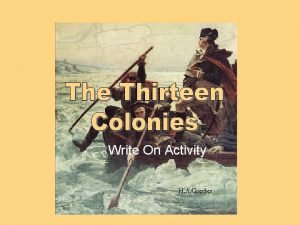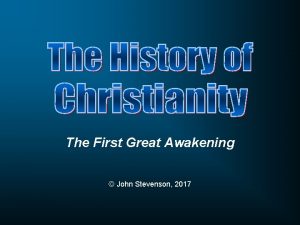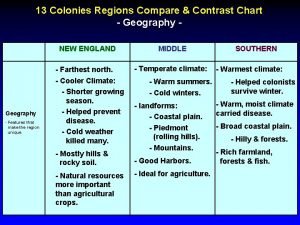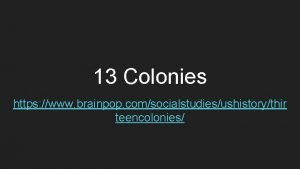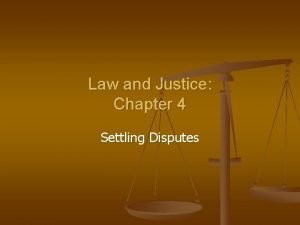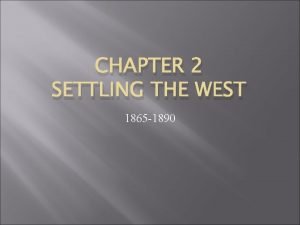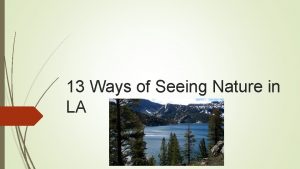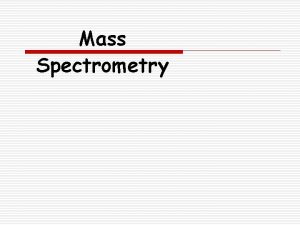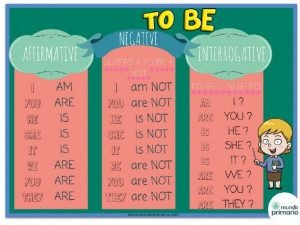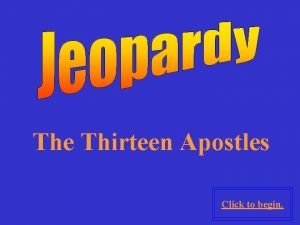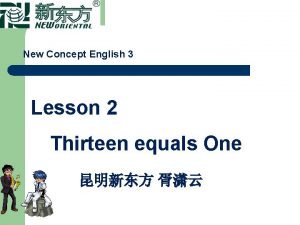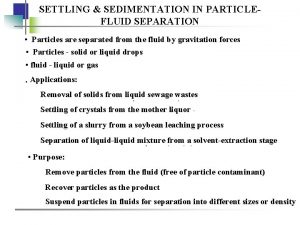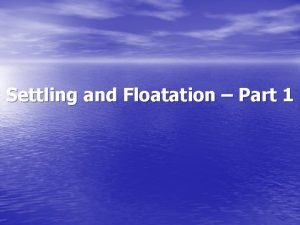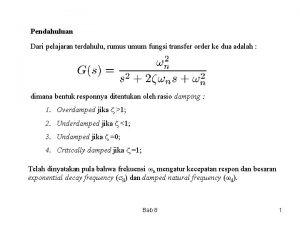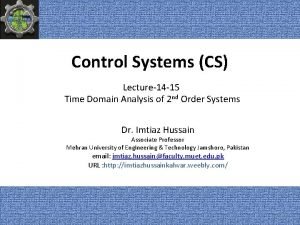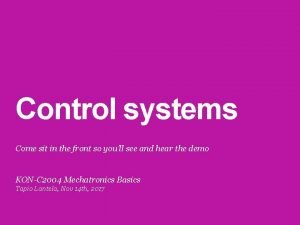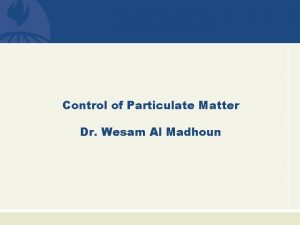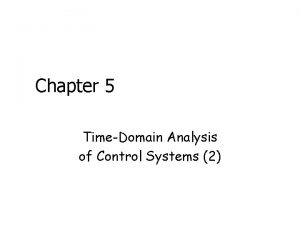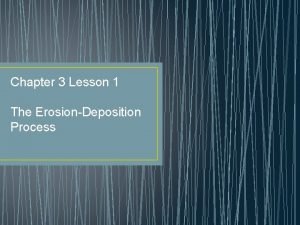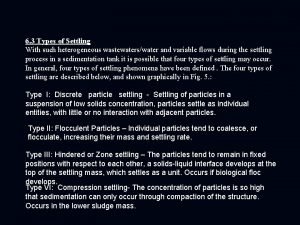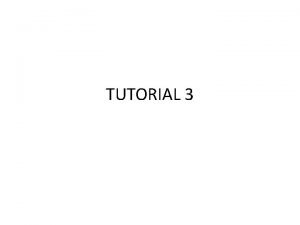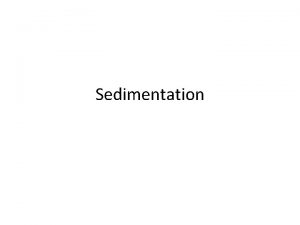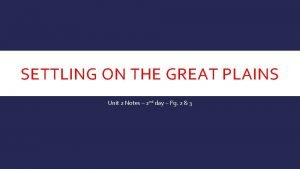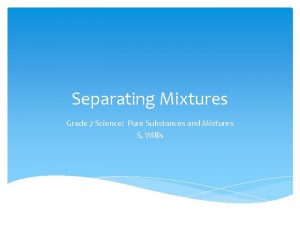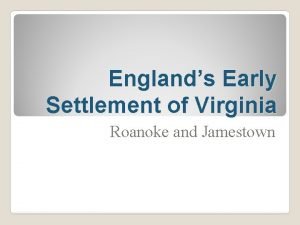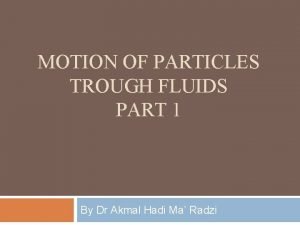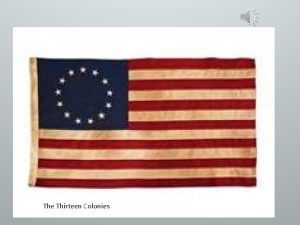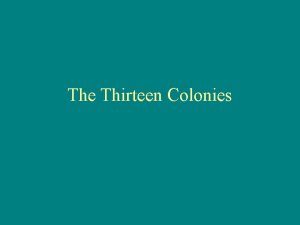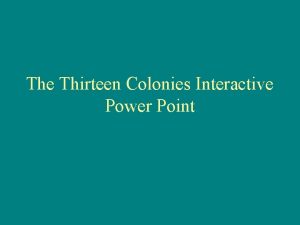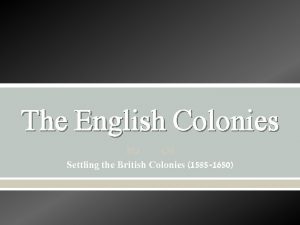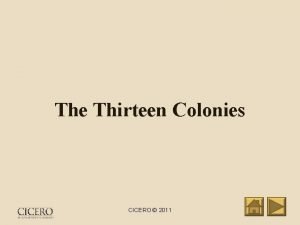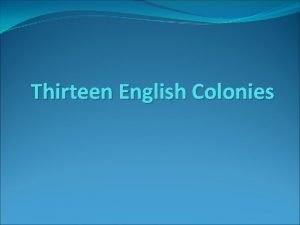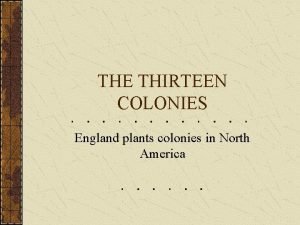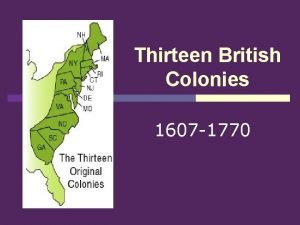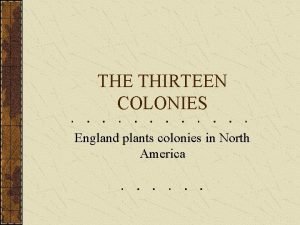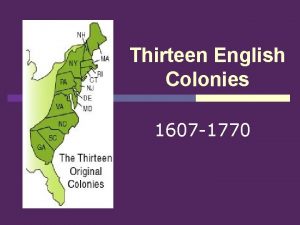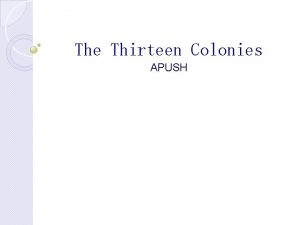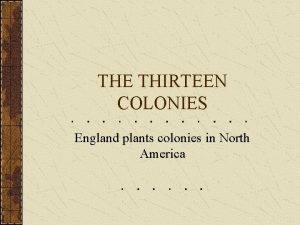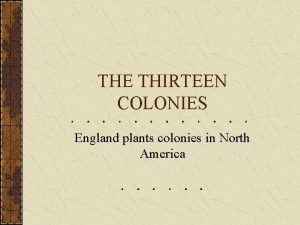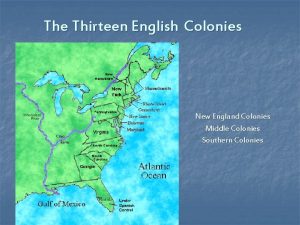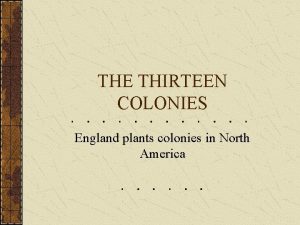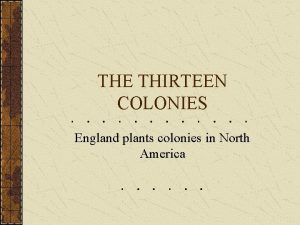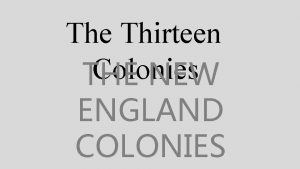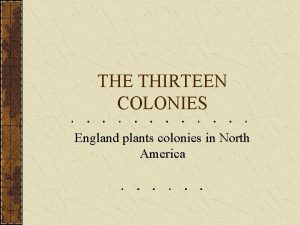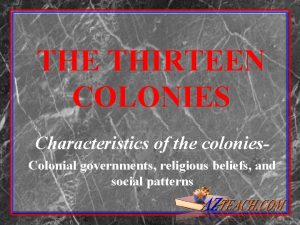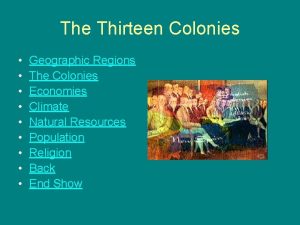CHAPTER 2 SETTLING THE THIRTEEN COLONIES Chapter 2








































- Slides: 40

CHAPTER 2 SETTLING THE THIRTEEN COLONIES

Chapter 2 – Settling the Thirteen Colonies • Reasons for English Colonization • economic freedom • political freedom • religious freedom • adventure pp. 16 -19

Chapter 2 – Settling the Thirteen Colonies pp. 16 -19 • Financial Support • joint-stock companies: companies in which the risks and rewards of a venture are shared with investors • Virginia Company: one of the best known joint-stock companies

Chapter 2 – Settling the Thirteen Colonies pp. 16 -19 • Colony Organization • charter colonies: founded by a charter containing the rules governing where the colony would be located and how it would be administered

Chapter 2 – Settling the Thirteen Colonies • proprietary colonies: given to individuals or groups by the king • royal (crown) colonies: controlled directly by the crown pp. 16 -19

Chapter 2 – Settling the Thirteen Colonies • Physical Hardships • ocean passage • food and shelter • Indians pp. 16 -19

Chapter 2 – Settling the Thirteen Colonies pp. 19 -26 The New England colonies were settled by those seeking religious freedom.

Chapter 2 – Settling the Thirteen Colonies pp. 19 -26 • Groups Opposing the Church of England • Puritans: wanted to purify the Church of England • Separatists: wanted to separate from the Church of England

Chapter 2 – Settling the Thirteen Colonies p. 19

Chapter 2 – Settling the Thirteen Colonies pp. 19 -26 • Plymouth Colony • a group of Separatists • moved to Leiden, Holland for religious freedom • later decided to move to the New World • known today as the Pilgrims

Chapter 2 – Settling the Thirteen Colonies • financing • English businessmen financed the Pilgrims’ venture in exchange for their profits. pp. 19 -26

Chapter 2 – Settling the Thirteen Colonies pp. 19 -26 • challenges of the voyage • unseaworthy ship (Speedwell) • storms • landed hundreds of miles north of Virginia

Chapter 2 – Settling the Thirteen Colonies • Mayflower Compact • first document to provide for selfgovernment in the New World • Indians • Samoset: the first to greet the English • Squanto: befriended the Pilgrims and helped them survive pp. 19 -26

Chapter 2 – Settling the Thirteen Colonies • William Bradford • governor of Plymouth Colony pp. 19 -26

Chapter 2 – Settling the Thirteen Colonies pp. 19 -26 • Reasons for Plymouth’s Early Success • learned from Jamestown’s experience • used to hard work • motivation

Chapter 2 – Settling the Thirteen Colonies pp. 19 -26 The Puritan attempt to reform the church from within had little success.

Chapter 2 – Settling the Thirteen Colonies pp. 19 -26 • Massachusetts Bay • establishment • “a city set upon a hill”: They desired their colony to be an example to the world. • John Winthrop: first governor

Chapter 2 – Settling the Thirteen Colonies pp. 19 -26 • “the Great Migration”: growth during the 1630 s in which over 15, 000 people came to the colony

Chapter 2 – Settling the Thirteen Colonies pp. 19 -26 • government • freeman: stockholders with full powers to govern the colony • General Court: representative body • believed in a strong relationship between church and state

Chapter 2 – Settling the Thirteen Colonies • Rhode Island • founded by Roger Williams • exiled by Massachusetts Bay in 1635 • became first colony to guarantee religious freedom pp. 19 -26

Chapter 2 – Settling the Thirteen Colonies pp. 19 -26 • Connecticut • founded by Thomas Hooker • Fundamental Orders of Connecticut, 1639: first written constitution in America

Chapter 2 – Settling the Thirteen Colonies • New Hampshire • founded due to overcrowding in Massachusetts • became a royal colony pp. 19 -26

Chapter 2 – Settling the Thirteen Colonies p. 26

Chapter 2 – Settling the Thirteen Colonies pp. 26 -29 New England was settled primarily by the English, who shared a common heritage. Several of the middle colonies, however, were influenced first by other nations.

Chapter 2 – Settling the Thirteen Colonies pp. 26 -29 • New Netherland (New York) • Henry Hudson: explored modern day New York, allowing the Dutch to claim the region

Chapter 2 – Settling the Thirteen Colonies pp. 26 -29 • mercantilism: an economic system that measures wealth by the amount of gold and silver a nation possesses • Peter Minuit: governor of the colony responsible for buying Manhattan from the Indians

Chapter 2 – Settling the Thirteen Colonies pp. 26 -29 • patroons: recipients of large land grants for bringing fifty settlers to the New World • Peter Stuyvesant: tyrannical governor of New Netherland

Chapter 2 – Settling the Thirteen Colonies pp. 26 -29 • Duke of York: given New Netherland by the English monarch (based on John Cabot’s earlier claim)

Chapter 2 – Settling the Thirteen Colonies pp. 26 -29 • New Jersey • given to Sir George Carteret and Lord John Berkeley by the Duke of York • promised cheap land, full religious liberty, and self-government

Chapter 2 – Settling the Thirteen Colonies • Pennsylvania • William Penn: founder (Penn’s woodland) • Quakers • beliefs: pacifists, human equality, “inner light” pp. 26 -29

Chapter 2 – Settling the Thirteen Colonies pp. 26 -29 • purpose of the colony: a religious haven for Quakers • Philadelphia (“city of brotherly love”): capital

Chapter 2 – Settling the Thirteen Colonies pp. 26 -29 • Delaware • at one time part of Penn’s holdings (granted by the Duke of York) • New Sweden: originally settled by the Swedes

Chapter 2 – Settling the Thirteen Colonies pp. 30 -32 The five southern colonies developed differently from the middle colonies and New England. They had warmer climates, single-crop economies, and slave labor systems.

Chapter 2 – Settling the Thirteen Colonies p. 30

Chapter 2 – Settling the Thirteen Colonies • Virginia • tobacco: Virginia’s leading crop • became a royal colony pp. 30 -32

Chapter 2 – Settling the Thirteen Colonies pp. 30 -32 • Maryland • Cecilius Calvert: founded the colony as a haven for Roman Catholics

Chapter 2 – Settling the Thirteen Colonies pp. 30 -32 • Act of Toleration: guaranteed religious freedom to all who believed in the Trinity • first written law guaranteeing religious freedom in the colonies

Chapter 2 – Settling the Thirteen Colonies pp. 30 -32 • The Carolinas • Charles II: rewarded his loyal followers with a New World territory • 1712: divided into north and south

Chapter 2 – Settling the Thirteen Colonies pp. 30 -32 • cash crops • North Carolina: tobacco • South Carolina: rice and indigo (made blue dye)

Chapter 2 – Settling the Thirteen Colonies • Georgia • founded by James Oglethorpe • purpose • debtor colony • buffer zone with Spanish Florida pp. 30 -32
 Original thirteen colonies
Original thirteen colonies 13 colonies quizlet
13 colonies quizlet 50 nifty united states from 13 original colonies
50 nifty united states from 13 original colonies North middle and southern colonies
North middle and southern colonies New york and philadelphia both brainpop
New york and philadelphia both brainpop Chapter 4 settling disputes
Chapter 4 settling disputes Native clothing
Native clothing Eleven twelve thirteen fourteen fifteen
Eleven twelve thirteen fourteen fifteen Thirteen ways of seeing nature in la summary
Thirteen ways of seeing nature in la summary Sdbsweb
Sdbsweb Freddy the thirteen
Freddy the thirteen Thirteen dogs
Thirteen dogs Thirteen apostles
Thirteen apostles Our vicar is always raising money for one cause or another
Our vicar is always raising money for one cause or another Where can we find rotating arm sprays in sewage treatment?
Where can we find rotating arm sprays in sewage treatment? Hazen formula for settling velocity
Hazen formula for settling velocity Solid spherical particles of coffee extract from a dryer
Solid spherical particles of coffee extract from a dryer Differential settling method
Differential settling method Examples of flotation and settling
Examples of flotation and settling Rumus fungsi transfer
Rumus fungsi transfer Gravitational settling chamber
Gravitational settling chamber Detention time in sedimentation tank
Detention time in sedimentation tank Peak time
Peak time Settling time control system
Settling time control system Gravitational settling chamber
Gravitational settling chamber Dominant poles
Dominant poles Lesson outline the erosion-deposition process answer key
Lesson outline the erosion-deposition process answer key Gravitational settling chamber
Gravitational settling chamber Settling types
Settling types Terminal velocity formula
Terminal velocity formula Sedimentation
Sedimentation Settling on the great plains section 2
Settling on the great plains section 2 How to separate mechanical mixtures
How to separate mechanical mixtures Late charges in front office
Late charges in front office Settling jamestown
Settling jamestown Settling the west part 2 packet- farming the plains
Settling the west part 2 packet- farming the plains Terminal velocity
Terminal velocity Dynamic response
Dynamic response Hát kết hợp bộ gõ cơ thể
Hát kết hợp bộ gõ cơ thể Lp html
Lp html Bổ thể
Bổ thể
